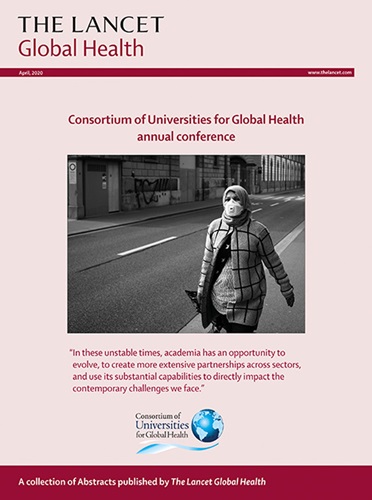Plasmodium falciparum carriage in a population under long-term, intensive malaria control in Kedougou region, Senegal: a 1-year cohort study.
IF 19.9
1区 医学
Q1 PUBLIC, ENVIRONMENTAL & OCCUPATIONAL HEALTH
引用次数: 0
Abstract
BACKGROUND In Sahelian Africa, successful interventions against malaria include vector control, improved access to care, and seasonal malaria chemoprevention (SMC) in children. However, malaria incidence has increased in the past 5 years. Up-to-date evidence is necessary to design additional interventions and restore progress towards elimination. In this study, we aimed to describe subclinical Plasmodium falciparum infections in the general population and understand the changes in prevalence, parasite densities, and clinical incidence across age groups and seasons, and to identify factors associated with P falciparum carriage in Kedougou, Senegal's most affected region. METHODS We included all individuals older than 6 months from randomly selected households of four villages in a 1-year open cohort. During four surveys spanning the dry and wet seasons, we collected sociodemographic and behavioural data, and detected P falciparum using quantitative PCR on capillary dried blood samples. We analysed risk factors associated with P falciparum carriage using multilevel logistic regression. FINDINGS We included 763 participants from 69 households, and they were followed up from April 13, 2021, to March 30, 2022. P falciparum prevalence was lowest in SMC-eligible children (aged <10 years) and remained below 10% across wet and dry seasons. Older age groups had similar dry season prevalence at baseline (10-15%). During the wet season, prevalence increased in individuals aged 15-24 years (32·1%) and 35-49 years (24·7%). The highest clinical burden was in participants aged 10-14 years (527 cases per 1000 person-years) and 15-19 years (631 cases per 1000 person-years), over five-fold higher than children aged 6 months to 4 years (93 cases per 1000 person-years). Outdoor night-time activity was associated with P falciparum infection. INTERPRETATION In this setting, ongoing intensive control reduced malaria in SMC-eligible children. Older individuals bear an important clinical burden and harbour high prevalence during the wet season. Elimination-oriented interventions must tackle the parasite reservoir, involving whole communities and specifically young adults. FUNDING Excellence Initiative of Aix-Marseille University-A*MIDEX, a French Investissements d'Avenir programme: the MARS project (A*Midex International 2018). TRANSLATION For the French translation of the abstract see Supplementary Materials section.塞内加尔凯杜古地区长期强化疟疾控制下人群中的恶性疟原虫携带:一项为期1年的队列研究
背景:在萨赫勒非洲,成功的疟疾干预措施包括病媒控制、改善护理可及性和儿童季节性疟疾化学预防(SMC)。然而,疟疾发病率在过去5年中有所增加。需要最新的证据来设计更多的干预措施并恢复消除进程。在本研究中,我们旨在描述一般人群的亚临床恶性疟原虫感染情况,了解不同年龄组和季节的流行率、寄生虫密度和临床发病率的变化,并确定塞内加尔受灾最严重的凯杜古地区恶性疟原虫携带的相关因素。方法我们从四个村庄随机抽取的家庭中选取年龄在6个月以上的个体作为1年的开放队列。在旱季和雨季的四次调查中,我们收集了社会人口学和行为数据,并对毛细管干血样本使用定量PCR检测了恶性疟原虫。我们使用多水平逻辑回归分析了与恶性疟原虫携带相关的危险因素。研究结果:我们纳入了来自69个家庭的763名参与者,并从2021年4月13日至2022年3月30日对他们进行了随访。恶性疟原虫患病率在符合smc条件的儿童(年龄<10岁)中最低,在旱季和雨季均低于10%。年龄较大的年龄组在基线时的旱季患病率相似(10-15%)。在丰水期,15 ~ 24岁(32.1%)和35 ~ 49岁(24.7%)的个体患病率增加。临床负担最高的是10-14岁(每1000人年527例)和15-19岁(每1000人年631例),比6个月至4岁儿童(每1000人年93例)高出5倍以上。户外夜间活动与恶性疟原虫感染有关。在这种情况下,持续的强化控制减少了符合smc条件的儿童的疟疾。老年人承担着重要的临床负担,在雨季发病率高。以消除为导向的干预措施必须解决寄生虫蓄水池问题,涉及整个社区,特别是年轻人。艾克斯-马赛大学- a *MIDEX资助卓越计划,法国投资项目:MARS项目(a *MIDEX International 2018)。摘要的法文译本见补充资料部分。
本文章由计算机程序翻译,如有差异,请以英文原文为准。
求助全文
约1分钟内获得全文
求助全文
来源期刊

Lancet Global Health
PUBLIC, ENVIRONMENTAL & OCCUPATIONAL HEALTH-
CiteScore
44.10
自引率
1.20%
发文量
763
审稿时长
10 weeks
期刊介绍:
The Lancet Global Health is an online publication that releases monthly open access (subscription-free) issues.Each issue includes original research, commentary, and correspondence.In addition to this, the publication also provides regular blog posts.
The main focus of The Lancet Global Health is on disadvantaged populations, which can include both entire economic regions and marginalized groups within prosperous nations.The publication prefers to cover topics related to reproductive, maternal, neonatal, child, and adolescent health; infectious diseases (including neglected tropical diseases); non-communicable diseases; mental health; the global health workforce; health systems; surgery; and health policy.
 求助内容:
求助内容: 应助结果提醒方式:
应助结果提醒方式:


